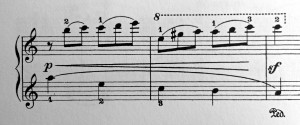Heller’s “L’avalanche, Op. 45, No. 2” Piano Play-Along: Post Two (Tricky Passages )
I’ve decided to extend our Heller “L’Avalanche” Play-Along a few more days what with the past TMTA Convention and future Piano Teacher Camp (June 27) occupying a good part of my time. Plus…. I wanted to get a couple more IG (Instagram) mini-video tutorials posted and ask for all your input on the following:
Now that you’ve been playing the piece for approximately 2 weeks (shorter for some of you), what do you think is the trickiest passage in the piece? Either for you or a potential student? Please COMMENT BELOW with measure nos.
I use the word “tricky” because I love how one of my students always uses that word in place of “hard” or “difficult.” Seems less daunting when described that way. Of course there might be more than one tricky passage that took you some time to work out or that you estimate would be “tricky” for students.
Here’s mine:
I’m fairly acquainted with this piece, but during my initial re-reading of the piece, this section caught me off-guard. A quick insert of contrary motion can certainly cause a little stumble in the reading process. I had to take a good look at the patterning in both hands. It’s the first time Heller has the 2 hands working in contrary motion with opposing melodic, rhythmic, and technical ideas. On the technical side, the LH is involved is a gradual rotation downward with a more open hand while the RH is playing fast passage-work upward with a closed hand. Tricky stuff.
Look forward to your REPLIES below! Share so we can all compare notes….Ok?












First let me say how fun it is to go back in time and play a piece I learned when I was young! And, I agree, Elizabeth, mm. 83-85 caught me off guard not only because of the contrary motion but my music had ledger lines instead of the 8va sign. The other sections I thought were “tricky” or can be for students were mm. 41-43 and mm. 57-59. I can see all the crossing over and hitting the correct note with the 4th finger causing problems. A real avalanche!
Yikes! All those ledger lines in the RH of mm. 83-84? Not good. Funny how you mention mm. 41-43 and 57-59. I’m about to post an Instagram video tute on that today. Could be an avalanche if they’re not careful. Ha! ha!
Yes, I agree about mm 83-85, but also mm 73-77. I have small hands and getting quickly to that stacked am chord is a bear. 🙂
Excellent point about the jumping around in this section. I agree! And reaching for/playing that rolled, stacked chord in a “risoluto” manner, with a small hand to boot, would be a problem. I have a 10-year old student working on this right now. Haven’t seen him in a couple of weeks so I wonder if he’s mastered that yet. I think he can play it rolled, but I wonder if he could make it accented (mm.75).
I agree mm 83-85 made me slow down and work. I too had ledger lines vs. 8va .
mm. 83-85 have also been the trickiest ones for me. I’ve had to drill them over and over. They just seem so abrupt and different from what has gone before.
Yes. I think the rhythmic shift at mm. 83, the sudden division between the hands on the first beat, and the sudden drop to P dynamic can send anyone into a tail spin. Try taking a tiny bit of time between the end of m. 82 and beginning of 83 in order to set the P dynamic nicely. Stopping the whirring energy with a little gap can help you start m. 83 a little more calmly.
I have really enjoyed your study and challenge on “L’avalanche”. It is an addicting piece! I am using this piece to jumpstart my own challenge of memorizing. I haven’t memorized a piece in many years and yet I ask my students to. This has been an interesting piece to analyze with its minor, diminished and major chords as well as the chord progressions.
Another interesting thing happened along the way came as I used the Faber and Palmer editions to practice from. I discovered the Palmer layout made m. 83-84 easier to prepare for and play!! Thanks also for showing us about the possibilities of Instagram! I’ve started a couple of my intermediate students on this piece now and we are all having fun!
Hi Kathy! So glad you enjoyed the Heller. I enjoyed getting to know it better as well. I haven’t taught it in quite some time. Thanks for the insight about the possibilities of chord analysis. This is an excellent specimen! Continue to have fun with it!